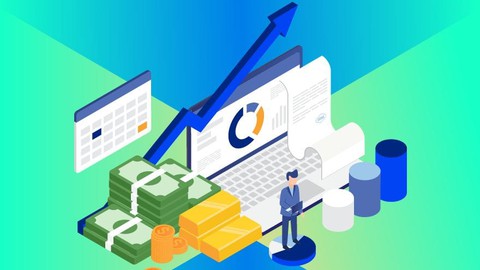
Module 6: Supply Chain Finance
Module 6: Supply Chain Finance, available at $19.99, has an average rating of 4.1, with 11 lectures, based on 45 reviews, and has 87 subscribers.
You will learn about Components of the financial statement Role of accounting Accounting concepts Asset or Expense Inventory valuation method Connecting supply chain transactions to financial statements Cost systems Activity Based Costing Working Capital Cash to Cash Cycle This course is ideal for individuals who are Beginners in Supply Chain or Supply Chain Professionals or Students or Consultants or Management Consultants or Business Analysts or Supply Chain Managers or Business owners or Accountants or Anyone from beginners & intermediate students who loves to learn step by step supply chain financial accounting It is particularly useful for Beginners in Supply Chain or Supply Chain Professionals or Students or Consultants or Management Consultants or Business Analysts or Supply Chain Managers or Business owners or Accountants or Anyone from beginners & intermediate students who loves to learn step by step supply chain financial accounting.
Enroll now: Module 6: Supply Chain Finance
Summary
Title: Module 6: Supply Chain Finance
Price: $19.99
Average Rating: 4.1
Number of Lectures: 11
Number of Published Lectures: 11
Number of Curriculum Items: 11
Number of Published Curriculum Objects: 11
Original Price: $19.99
Quality Status: approved
Status: Live
What You Will Learn
- Components of the financial statement
- Role of accounting
- Accounting concepts
- Asset or Expense
- Inventory valuation method
- Connecting supply chain transactions to financial statements
- Cost systems
- Activity Based Costing
- Working Capital
- Cash to Cash Cycle
Who Should Attend
- Beginners in Supply Chain
- Supply Chain Professionals
- Students
- Consultants
- Management Consultants
- Business Analysts
- Supply Chain Managers
- Business owners
- Accountants
- Anyone from beginners & intermediate students who loves to learn step by step supply chain financial accounting
Target Audiences
- Beginners in Supply Chain
- Supply Chain Professionals
- Students
- Consultants
- Management Consultants
- Business Analysts
- Supply Chain Managers
- Business owners
- Accountants
- Anyone from beginners & intermediate students who loves to learn step by step supply chain financial accounting
Our objective with this particular module is to help supply chain practitioner, make a link between all the things that we do in the supply chain. For instance, make products, store, move products with trucks and make a link between that and the financial statements. This is critical because while we live in this world, senior executives live more often than not in this particular world, where they understand financial terms. Now, supply chain managers have an enormous amount of control over the assets of the firm. In particular, we’ll talk about working capital. And that’s one of the critical things, which we in the supply chain manage a big portion of. And the challenge that we have is that we have to be able to explain and understand how are the decisions that we make in the supply chain. We’re going to provide you with the basic understanding of how transactions– could be the purchase of raw material, could be the sale of a product, could be the transfer of a title– how those transactions find their way to both the income statement and the balance sheet, and what that means to the firm’s financial performance. If we are able to do that, then we’re actually able to take what we do in the supply chain and articulate the value in financial terms that we’re adding to the firm. Now, we’ve tried this in past years. All of us in the supply chain, we’ve tried to explain what it is that we do in terms of inventory turns and cycle times. Try to explain that to an executive, their eyes glaze over. You talk about impact on revenue, you talk about impact on working capital, their eyes are going to light up. And this is where we make the connection between, again, what we do in the supply chain world and what is reported in the financial reports. Now, there’s two particular lessons. The first lesson is really going to be focusing on two very critical financial reports– the income statement and then the balance sheet. The income statement, of course, where we report the revenues of the firm, the money we bring in– the recognize that we show the costs and then the net profit. The assets report at a snapshot in time, one point in time, though all the obligations that the firm has to pay out and the liabilities in shareholders’ equity, but also all the things that the firm owns that are all value. And so that’s the first particular lesson. The second lesson we’re going to be focusing on understanding cost systems and how costs are reported. And then we’ll talk about working capital. This is the capital we use to run and operate the business. And then that will lead us to understand and at least talk about the cash conversion cycle, where there are three components– the days of inventory outstanding, the days of sales outstanding, and the days of payables outstanding. Three really important measures that add up, tell us how long it is that we have to invest one unit of currency to get some currency back in the supply chain. That’s the cash conversion cycle.
So let’s get started.
Course Curriculum
Chapter 1: Accounting Fundamentals
Lecture 1: Introduction
Lecture 2: Components of the Financial Statement
Lecture 3: Role of Accounting
Lecture 4: Accounting Concepts
Lecture 5: Asset or Expense
Lecture 6: Inventory Valuation Method
Lecture 7: Connecting Supply Chain Transactions to Financial Statements
Chapter 2: Cost Accounting
Lecture 1: Cost Systems
Lecture 2: Activity Based Costing
Lecture 3: Working Capital
Lecture 4: Cash to Cash Cycle
Instructors
-
Muhammad Saad
Mechanical Engineer | Micro Masters Supply Chain MIT (USA) -
Uzair Khan
MSc Artificial Intelligence & Data Science | Mechanical Eng
Rating Distribution
- 1 stars: 1 votes
- 2 stars: 1 votes
- 3 stars: 3 votes
- 4 stars: 2 votes
- 5 stars: 38 votes
Frequently Asked Questions
How long do I have access to the course materials?
You can view and review the lecture materials indefinitely, like an on-demand channel.
Can I take my courses with me wherever I go?
Definitely! If you have an internet connection, courses on Udemy are available on any device at any time. If you don’t have an internet connection, some instructors also let their students download course lectures. That’s up to the instructor though, so make sure you get on their good side!
You may also like
- Top 10 Emotional Intelligence Courses to Learn in December 2024
- Top 10 Time Management Courses to Learn in December 2024
- Top 10 Remote Work Strategies Courses to Learn in December 2024
- Top 10 Freelancing Courses to Learn in December 2024
- Top 10 E-commerce Strategies Courses to Learn in December 2024
- Top 10 Personal Branding Courses to Learn in December 2024
- Top 10 Stock Market Trading Courses to Learn in December 2024
- Top 10 Real Estate Investing Courses to Learn in December 2024
- Top 10 Financial Technology Courses to Learn in December 2024
- Top 10 Agile Methodologies Courses to Learn in December 2024
- Top 10 Project Management Courses to Learn in December 2024
- Top 10 Leadership Skills Courses to Learn in December 2024
- Top 10 Public Speaking Courses to Learn in December 2024
- Top 10 Affiliate Marketing Courses to Learn in December 2024
- Top 10 Email Marketing Courses to Learn in December 2024
- Top 10 Social Media Management Courses to Learn in December 2024
- Top 10 SEO Optimization Courses to Learn in December 2024
- Top 10 Content Creation Courses to Learn in December 2024
- Top 10 Game Development Courses to Learn in December 2024
- Top 10 Software Testing Courses to Learn in December 2024






















